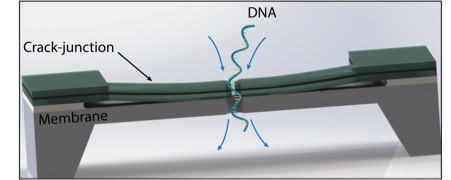Million rain over KTH for interdisciplinary project
A research team lead by Göran Stemme, Professor in Micro and Nanosystems, has been awarded 26.5 MSEK by the Swedish Research Council for a seven year interdisciplinary research project. The project will lay the foundation for a next-generation high throughput DNA and RNA sequencing technology.

The project brings together a combined expertise spanning molecular biology and bioinformatics, genomics, micro and nanofabrication, microfluidics, surface chemistry, signal processing and machine learning.
The new sequencing technology builds on a recent breakthrough in nanofabrication that makes it possible to reliably realize millions of sub-2 nm nanogap electrodes. By integrating the electrodes with nanopores, single strands of DNA or RNA that pass through the nanopores will interact with an electron tunneling current, enabling the molecule to be electronically read. The modulated tunneling current will then interpreted using model-based machine learning algorithms to identify, for instance, individual nucleotides in the case of DNA.
“It is an honor to be given the chance to pursue basic research on a fundamental technology that could one day have a significant impact on biology and medicine. The interdisciplinary nature of our team, and the duration and scale of this grant will allow us to span the entire toolchain from sensor development, through sample preparation and data processing, to the biologically relevant questions, ensuring the long-term practical relevance of our work," Stemme says.
The project named “QuantumSense – Quantum Tunneling Sensing of Biomolecules for High-Throughput Decoding of DNA and RNA”, was the largest of three projects awarded with KTH as coordinating organization within the call for research environment grants for interdisciplinary research. Overall, KTH was the most successful individual organization in a highly completive call, where only 6 percent of all applications were selected for funding.
Team members
- Professor Göran Stemme, the PI, heads the Department of Micro and Nanosystems at the School of Electrical Engineering and Computer Science (EECS) at KTH. MEMS, Nanofabrication, Sensors.
- Professor. Joakim Lundeberg heads the National Genomics Infrastructure (NGI) in Stockholm and the Dept. of Gene Technologies at the School of Engineering Sciences in Chemistry, Biotechnology and Health (CBH) at KTH. His research group is part of the Science for Life Laboratory (SciLifeLab) in Stockholm. Genomic technologies, Molecular biology, Bioinformatics.
- Associate Professor Anna Herland leads the group on “In vitro neural models and Hybrid Bioelectrical Systems” at the Department of Micro and Nanosystems at the School of EECS at KTH. She is also affiliated with the Department of Physiology and Pharmacology at the Karolinska Institute (KI). Microfluidics, Surface Chemistry, Molecular Biology.
- Joakim Jaldénis Professor of Signal Processing at the Department of Information Science and Engineering at the School of EECS at KTH.Signal processing, Algorithm development, Machine learning.
- Cecilia Williamsis Professor of Experimental Oncology and heads the division of Cellular and Clinical Proteomics at the Deptartment of Protein Sciences at CBH, KTH. She is also a visiting professor at the Dept. of Biosciences and Nutrition at the Karolinska Institute. Her research group is located at the SciLifeLab in Stockholm. Experimental oncology, Molecular biology.
